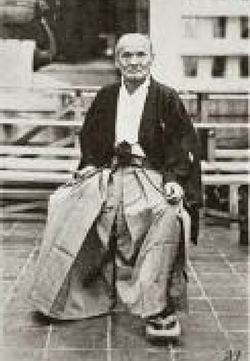

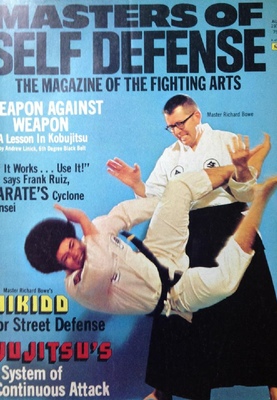
Inside Nihon Goshin Aikido ~ #28
July 5, 2015
In This Issue:
- Sho-Dan Testing ~ What You Need to Know (Part 2) A. Movement ~ It Should Be Your Best Technique
B. Staying Fresh During the Attack Line
- Hokkaido 2020: My Proposal to Re-launch a Nihon Goshin Aikido Dojo in Chitose, on the Island of Hokkaido in Japan by 2020
- Growing Our Subscriber Base ~ Please Forward to your Friends and training buddies
- Announcements: Chris Leventis to San-Dan. Got a rank promotion, opening a new dojo, hosting a seminar, etc.
Greetings Nihon Goshin Aikido Aficionado!
It’s July and it’s “HOT!” In the south, there are just some days that it’s too hot to even talk, much less type, so enough with the odd introductory filler. Here are some aikido musings for your consideration.
1. The Sho-Dan Test. What You Need to Know
(Part 2)
Last month we discussed some ideas to help you prepare for your upcoming sho-dan test, and I wanted to continue looking at some more ideas that might help us. In the previous month’s newsletter, we addressed the importance of continuing to train after sho-dan, and remaining composed during every type of attack from every type of attacker. Those ideas have received their own category on a page called, “Testing For Shodan”) on the website, and are listed here, and we’ll add articles to this page periodically, and please feel free to share your experiences an insights also.
In this month’s edition of “Inside Nihon Goshin Aikido,” I wanted to expand our list of sho-dan testing considerations and look at some other concepts that might help you during your test.
Before we get started, take a minute to name all 50 of the Classical Techniques. Run through the list in your head as fast as you can. Now consider this question: “Which technique will you use the most during your test?”
If your list looks like most I’ve seen, there will be heavy doses of Arm Bars, Elbow Chops, Front Wrist Throws and Peel Offs. Throw in a few High Bridges, Pivot Take Downs, Slaps to the Side of the Head, and a Spin Around or two, and you’ve probably accounted for 75% of the techniques you’ll end up using. All that said, if your list is a version of that list, well you’ve fallen into a serious trap.
“Trap?” ~~~ You bet.
THE Technique You Will Use More Than Any Other On Your Sho-Dan test is not one of the 50 Classical Techniques. Furthermore, the Technique you will use most should be indelibly identifiable in every attack. “What is this all encompassing technique?” ~~~~ It is your Initial Movement.
“Blending,” “Entering,” “Turning,” “Twisting,” (Tenkan, Irimi, Tenkai, Tenshin, Irimi-Tenkan, etc., etc.). Call it what you will, but you should be moving in an identifiable “non-staggering/ non-shuffling motion.” We don’t want to get too caught up in the details of movement in this newsletter, but you have to master these concepts if your aikido is going to flow like water.
Watch enough tests for sho-dan, and you will see instances when Initial Movement takes a back seat to fatigue, or a loss of focus. A static, unmoving, nage is an easy target, and an ugly aikidoka. Without movement aikido is forced to rely on muscle, and it gets ugly in the process. We are working on a martial art ~ mind you. Not a collection or set of self defense tactics. In the name itself, “martial art,” there is an implied beauty, and we should strive to have that beautiful essence in our practice and on our test at all times.
Back to the test. Keep in mind that you are expecting the attack when it comes on the test. If you have extended periods of static responses, or sloppy Initial Movements on the test, how will you respond on the street, where you will most likely be surprised by the sudden onset of violence ~ when there is no second chance? Whether our motivation is “beauty” or “effectiveness,” (and I submit your goal should be both), precise and clear Initial Movements must be an ingrained, conditioned, and automatic response in your psyche for every attack.
For testing purposes, the greater point is that you’ve got to respond to uke’s attack with some fashion of an initial movement. In my mind, every Initial Movement you utilize should be clear to everyone watching on every attack.
Over the last 6 months or so, I’ve been working on getting together a list of possible Initial Movements ~ complete with my own rudimentary footwork diagrams, etc. I believe this list (summarized here) details most possibilities, and also creates great angles for follow-up up technique.
Rather than review them all here in the newsletter, I’ll just analyze my current favorite Initial Movement: The Tenshin Movement, and direct you to the Movement Principles part of the website for more detail on the others.
The Tenshin Movement. Let me be clear. The Tenshin Movement is the bomb. Put it in your arsenal of Initial Movements; you will not regret the decision.
Generally speaking the Tenshin Movement is back and off line from the attack. Dale Roznowski once explained the Tenshin Movement to me as a “backwards hamni walk” (assuming you were in a hamni stance at the onset), and I think this is a very good starting point for our definition. Of course, we will most likely be in shizentai when attacked (neutral stance), so things might get confusing if you think about it solely as a backwards hamni walk initially. Not to complicate the matter further, but we should also mention that the Tenshin Movement is not exactly a footwork pattern as much as it is a Movement Philosophy in which uke is drawn into the space nage was just occupying and is off balanced..... But why confuse things? ~~~ lol
Are you still with me? If I lost you, let me try to reel you back in here. On the point. Rather than getting bogged down in the finer details, or the “how”, let’s focus on the “why” of the movement because understanding “why the tenshin movement is useful” is the key motivation toward its synthesis in your own freestyle aikido training.
So, “Why?” The general idea or purpose of the Tenshin Movement is to Draw uke into the space Nage just occupied. As previously discussed, it is a movement that is back and slightly off line. It buys time for nage at uke’s own peril. It is a strategic retreat that sucks uke past his operating center into an over extended, unbalanced, and extremely vulnerable position. I works well on slow attacks, fast attacks (as stepping back is the more natural reaction to a fast and unexpected attack), round attacks and straight attacks. It’s origins are in sword movements were you hold a line as long as you can, and then move back and away to create a new line that flanks uke, as you unbalance him.
In Aikido of Charlotte’s Summer Friendship Seminar this past June 2015, Sensei Dennis Main asked me to serve as his uke in one of his final demonstrations of the day. The attack was a straight punch to the face. We were in gyaku hamni (my right foot was forward and his left foot was forward). As I attacked, he stepped back and offline, and extended my attack through the place his center line used to be, and then drew my hand down into his new center. This is the Tenshin Movement.
He did the initial Tenshin movement, and stopped before applying the technique. I did my best to not fall down.
After a pause that allowed me to recover just enough, he did an effortless Spinning Hip Throw Application that sent me sailing across the mat back in the direction I had come from. I rolled, recovered, and was privileged to be asked to attack him a few more times. On maybe the third attack, he began to lower his center as he moved back, and I did nearly drop to my knees at that point (all before any technique was applied).
It was a powerful testament to the Tenshin movement’s potential. After the first attack, I knew what he was going to do and how he would go about doing it, but the instant I tried to “touch” his chin with my fist, I was unwittingly transitioned into an extremely precarious situation, that led to effortless and powerful aikido technique.
This is the magic of sound initial movement, and so many times this idea gets lost on the sho-dan test in favor of the muscular application of technique in the absence of initial movement. Fight against this tendency to become a stature on your own test! As one of our founding father’s once said, “Give Me Tenshin Movements Or Give Me Death!”
Or
In the words of one of our Nihon Goshin Aikido Yudanshakai, “I want to move like a little girl and throw like a Greyhound Bus.” If you get your initial movement down, you will throw like a bus ~ if (and exactly when) you want to. I guarantee it.
A picture is worth a thousand words, so lets consider a few pictures to the left and a video. Here is an article I previously wrote on the Tenshin Movement.
One last point. In terms of the initial movements, the Tenshin Movement is not one we see a lot of in our art, but it is insanely useful, and devastatingly powerful. I encourage you to explore it’s usefulness in your own training.
How to Pace Your Defenses in the Attack/ Self Defense Line So You Stay Fresh the Entire Sho-Dan Test:
2 months before my own sho-dan test, I competed in my first bodybuilding contest (where I managed to finish dead last in the Masters Over 40 Division, and second to last in the Novice Division). Did I mention that I’m a pretty terrible bodybuilder? That said ~ I was extremely lean when I tested for Sho-dan. I think I weighed around 185 pounds at the time of the test, which is a lot less than the 220 pounds I had been carrying around prior. Still despite the lost weight, I struggled with fatigue issues during the multi attacker portion of my test. Staying fresh would have improved my finish, and could possibly improve yours also. So how do we stay fresh longer?
Here are two suggestions.
Suggestion A: Breathe:
As you execute your techniques, think about your breathing. I seem to be fond of holding my breath during techniques for some reason. I do not recommend the practice, however, as excessive holding of one’s breath is not conducive to consciousness. So breath ~ and breath frequently. How though?
Well, Kiais (short martial shout uttered when performing an attack) help you breath, but they might work against you if you find yourself tensing up as you kiai. If you tense up, you lose the relaxed aikido feeling we’re trying to establish, and you might not breathe normally after that. Truth be told relying exclusively on the kiai might be counterproductive.
One of the things I’ve been thinking about some is the idea of exhaling when I respond to the attack and inhaling as I perform technique ~ which is essentially a silent kiai. This is a real hit miss operation for me right now, but it something all soon to be sho-dans need to be considering.
Suggestion B: Pin Don’t Project:
When you begin to feel fatigue creeping in, consider this: after uke’s initial attack, link a few techniques together. Make the transition from each technique more slowly than the previous one ~ to demonstrate control. Then slowly take Uke to the ground and methodically pin him (take 10 seconds, or more, on the pin). After uke taps, slowly release the pin, and recover into a ready position relative to uke. After uke has recovered, reorient yourself to the attack line and prepare for the next attack.
Slowing the transitions and pinning sequence down will slow your work rate down, demonstrate maximum control to your evaluator. It will also allow you to catch your breath during the pin! Do not wait until you begin to feel exhausted to start doing this. As soon as you begin to feel like you’re a little winded, starting pinning uke.
Of course, if you do pin uke excessively, your test will last for a couple of days (watch my sho-dan test as an example of a test that lasted over an hour as a case in point), but if every third or forth attack results in a pin, you can use pinning opportunities to slow things down and catch your breath without extending your test too long.
What say ye?
2. “Hokkaido 2020:” My Proposal to Re-launch a Nihon Goshin Aikido Dojo in Chitose, Hokkaido Japan
When John F. Kennedy looked up at the moon and said, “In 10 years we will be there” America took note. A goal was stated. A vision was cast. A dream became reality.
In the same manner, last month I cast a vision I called “Hokkaido 2020” ~ with a stated goal to establish a Nihon Goshin Aikido Dojo in Chitose on the island of Hokkaido in Japan (the town the original Nihon Goshin Aikido dojo was located) by January 2020. Unfortunately, I’m not the president. I’m more like Jules Verne ~ someone with an idea, but no power to follow through. Call me a dreamer.
In the previous edition of the newsletter, we discussed what it might take to establish a Nihon Goshin Aikido Dojo in Chitose, Hokkaido Japan. The entire article has sense been moved to its own page, and can be read in total here.
If Hokkaido 2020 is ever to become more than just a dream, we need to begin making a plan. We also need to begin the process of grooming a teacher.
As to the teacher, well he needs to have a missionary’s heart for the art.” This teacher must be willing to relocate his/ her family into a cross cultural setting, and be ready to self support to some capacity initially. He/ she must commit to remaining in Chitose until the dojo is established, and he must also be flexible enough to know when the job is done. At some point, the dojo might be turned over to a trained Japanese student who achieved sho-dan in our art. Probably most importantly, this teacher must also feel “called” to go. Do any of us feel that calling?
As to planning, well, I’m not the one to do it. I’m leaving the planning to the senior leadership of our art. That said, it should be a unified dream and vision of all our leadership, and their students. For the effort to succeed, the combined leverage of ALL Nihon Goshin Aikido Dojos regardless of association/ federation/ Sensei loyalties should be rallied.
A board of directors composed of representatives from all willing vectors should be established/ elected to select, supervise, encourage, and provide council to the chosen instructor, and keep all Nihon Goshin Aikido dojos informed as to the progress (possibly even through a regular column here on NGAexperience.com.
The board (recommend a not-for profit status) would also support and provide accounting services for all funds raised, etc. “Hokkaido 2020” should not be considered to be a “solo operation” ~ where a Sensei just takes off on the fly to accomplish the mission on his own. It should be a concerted outreach effort on all fronts, and a goal for all of our dojos.
As I said, I’m just a vision caster with no inherent authority. If “Hokkaido 2020” takes shape to move forward, it will take the combined efforts of our senior leadership in all associations working toward this common goal.
As a parting thought on “Hokkaido 2020,” from last month’s issue, I concluded in this fashion, and I believe it bears restating ~ and perhaps worded in a stronger fashion. “If we can not unite around the concept of reintroducing Shodo Morita’s art to his hometown in Chitose, there is nothing we can reunite around.” So who wants to take charge of this project, and who wants to go to Japan?
3. Newsletter Subscribers:
More subscribers is the goal ~ so can you help us grow our Newsletter Subscription Base by passing the website along to your training buddies and asking them to subscribe?
Our hope is to be an inter-dojo clearing house for all things NGA, but we need more subscribers to do that. Best of all, it’s free, and who doesn’t like the word “free!” Click Here to Subscribe! (And make sure your forward to all your training buddies, and would be training buddies).
5. Announcements:
Congratulations to Sensei Chris Leventis who received his San-Dan from Shihan Steven Weber at a seminar in Florida last month.
In his own words: “Last night I had the privilege and honor of being promoted to San-Dan (3rd Degree) by my instructor Shihan Weber. Although I don't train in the Martial Arts to achieve rank it was a great feeling of accomplishment to reach this level after 24 years of training in the art of Nihon Goshin Aikido. As I'm surrounded by my students, colleagues and friends I am overwhelmed by the impact the Martial Arts has made in my life and forever determined to continue on this path and grow as a martial artist. The path never ends.”
We would like to share your information on Seminars, Dojo Expansions, Relocations, Grand Openings, Promotions, and/or Other Information with our subscribers. Please forward all of your announcements to us? Send us the information on it and we’ll post it here for you.
Stay tuned, and let's meet on the mat together soon!
Best,
Jonathan Wilson
ngaexperience.com

Hokkaido 2020: Which One of You Will Spearhead the Effort to Re-Establish a Nihon Goshin Aikido Dojo in Chitose, on the island of Hokkaido in Japan by January 2020?


2014 - 2021 ngaexperience.com
Unless otherwise stated, the author’s views, musings, and opinions do not necessarily reflect the attitude of leadership within any of the various Nihon Goshin Aikido associations, or unaffiliated Nihon Goshin Aikido dojos.

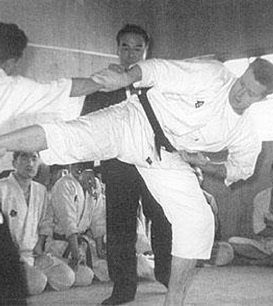
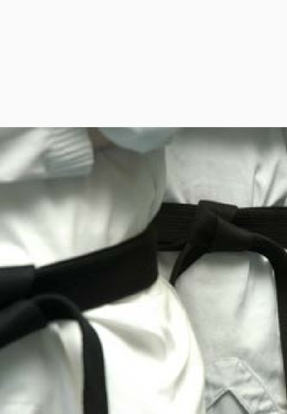

The best time to plant a tree was 20 years ago. The second best time to plant a tree is today.
Click here for a list of Nihon Goshin Aikido Dojos ~ and begin training with us today!

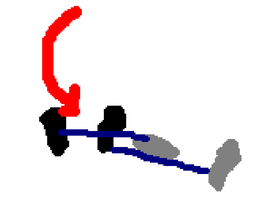
The Tenshin Movement ~ modified to operate out of a shizentai stance. It is a movement back and off line, offering tremendous kuzushi (balance breaking) opportunities. The Tenshin movement works especially well against round attacks. Unlike Irimi and Tenkan Movements, the Tenshin Movement draws uke into the space nage was holding.
The Tenshin Movement

When people think of studying aikido ~ if they have done any research at all ~ one of the things they assume they will learn is “how to roll.” If we do not teach them to roll well early, their chances of getting injured in the process of learning aikido will be far greater than their chances of getting attacked on the street. #weberollin’

The Tenshin Movement demonstrated.
Note how nage controls uke’s striking hand past the center line and into kuzushi.


The Tenshin Movement ~ draws uke into the space nage was holding ~ unbalancing him. Uke’s back heel rising is a sign it’s being done well.
The Tenshin Movement
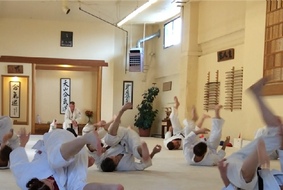
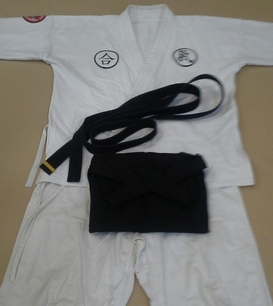

The Classic Lines of the Nihon Goshin Aikido training gi are unmistakable.
- White Gi
- “Ai” patch on the right breast
- “Ki” patch on the left breast
- Association patch on the right shoulder.
- Applicable belt (white, yellow, blue, green, purple, brown, black),
- Black hakama (worn only by those who have achieved a black belt in Nihon Goshin Aikido)
Some things simply never change. The student/ instructor uniform is one of those things. It marks a connection all the way back to the Chitose dojo, and should be preserved.
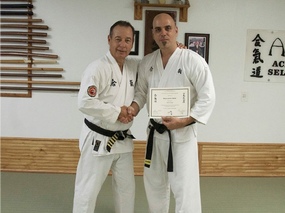

Shihan Weber after promoting Cris Leventis to San-Dan on
26 June 2015.

